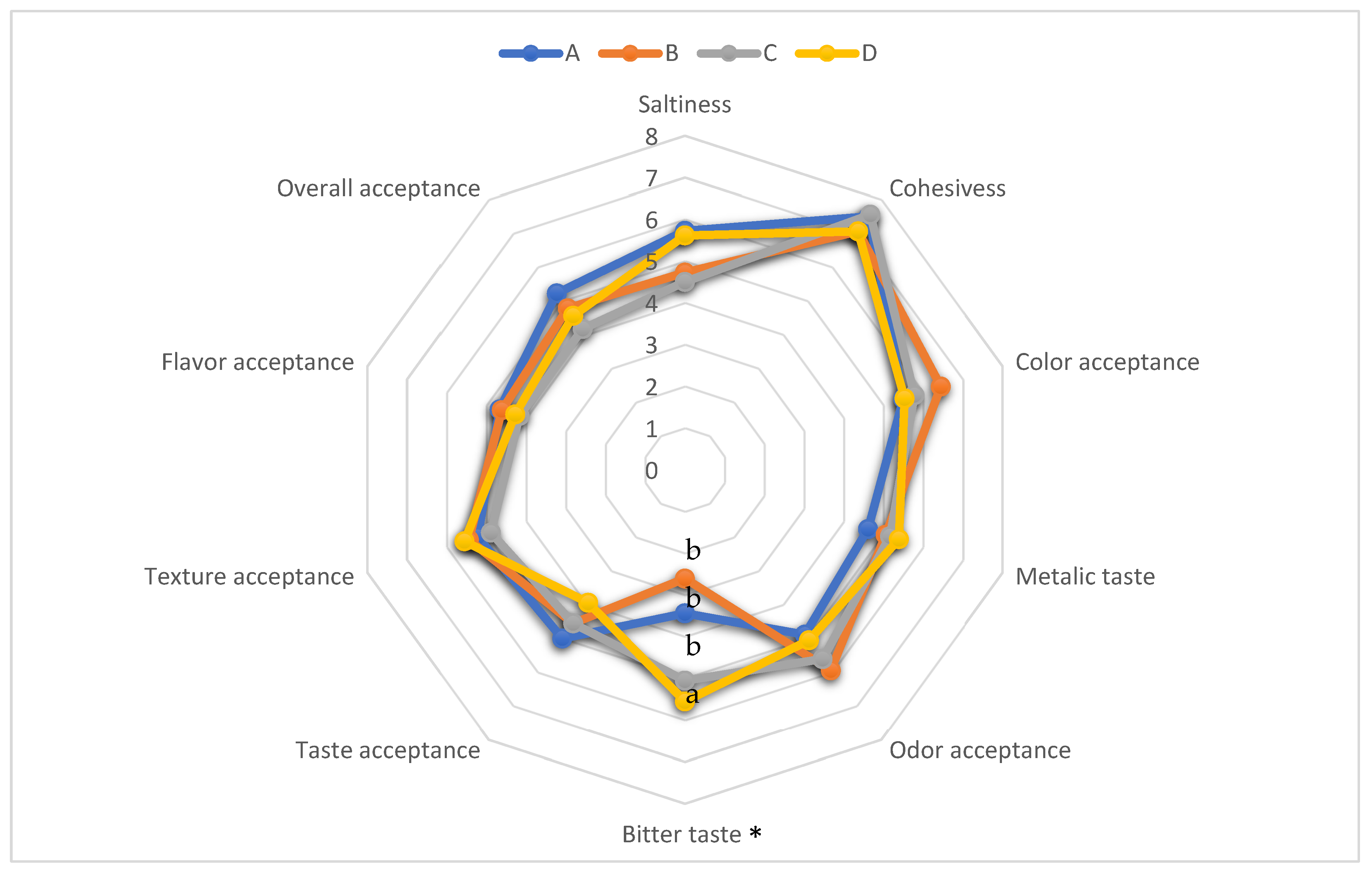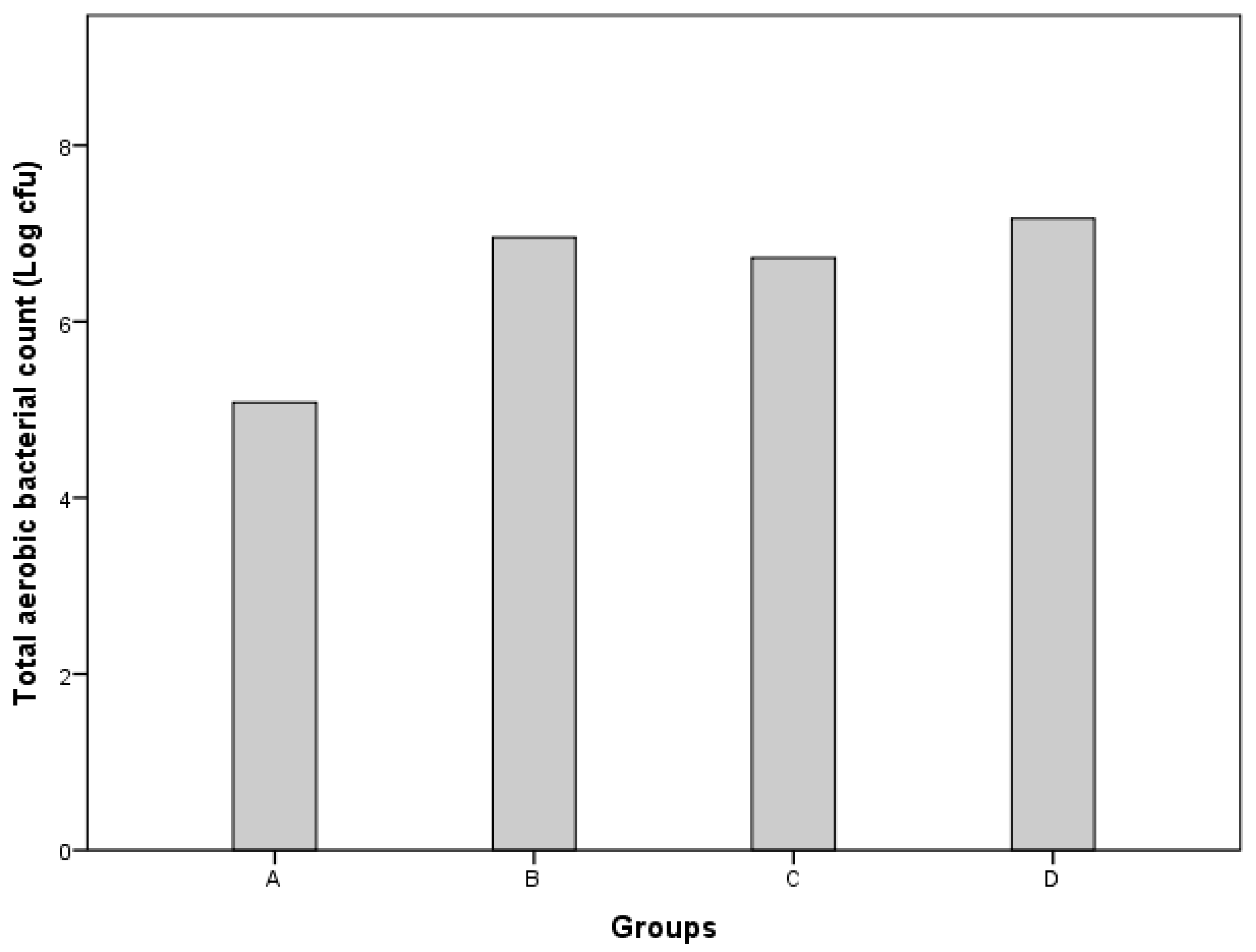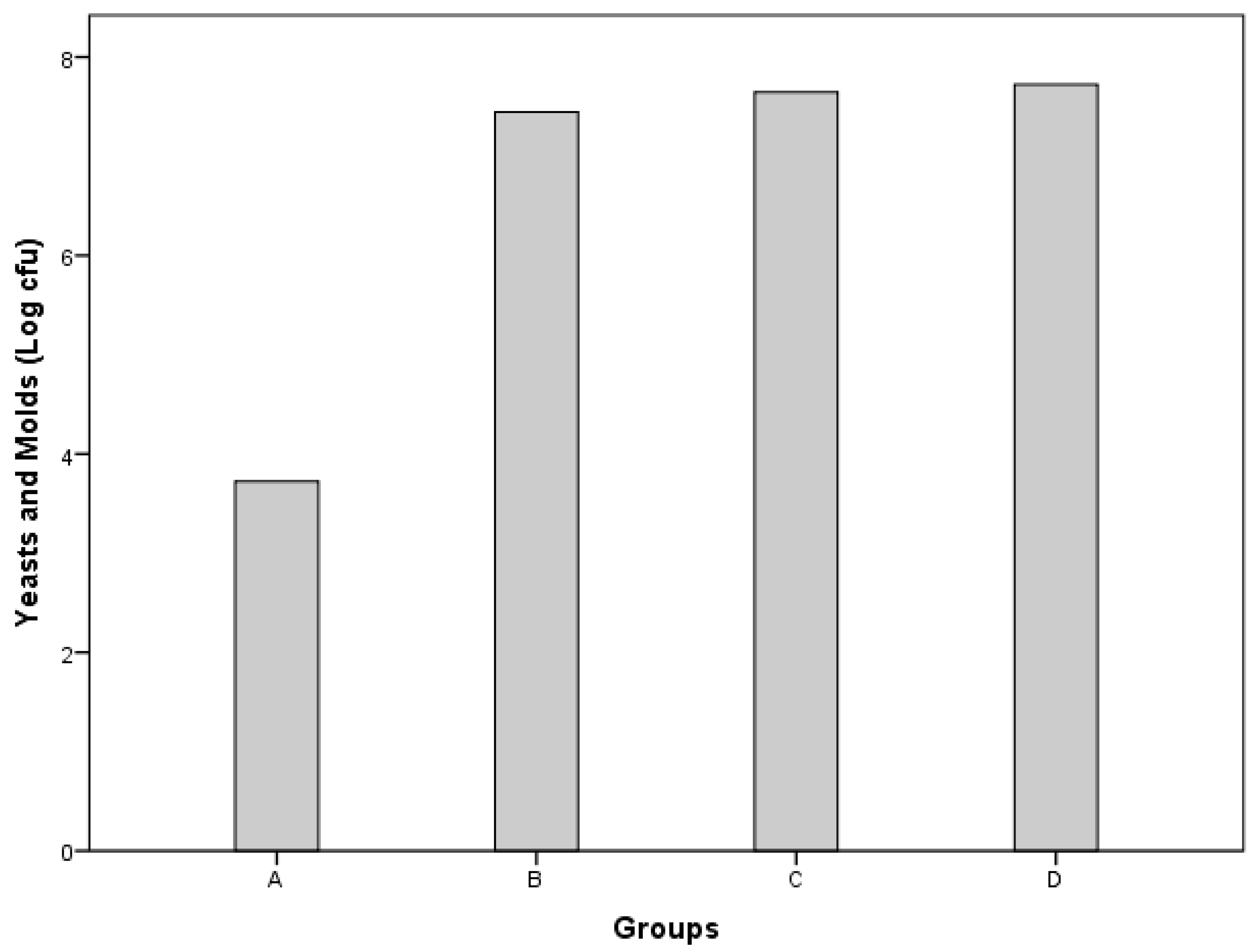Effect of Carrot Pulp Incorporation and Partial Sodium Chloride Replacement on Hybrid Burger Characteristics
Abstract
1. Introduction
2. Materials and Methods
2.1. Sample Preparation
2.2. Color Indices
2.3. pH Measurements
2.4. Microbiological Analysis
2.5. Sensory Analysis
2.6. Water-Holding Capacity (WHC)
2.7. Cooking Loss
2.8. Textural Profile Analysis (TPA)
2.9. Statistical Analysis
3. Results and Discussion
4. Conclusions
Author Contributions
Funding
Institutional Review Board Statement
Informed Consent Statement
Data Availability Statement
Acknowledgments
Conflicts of Interest
Abbreviations
| WHC | Water-Holding Capacity |
| PCA | Plate Count Agar |
| PDA | Potato Dextrose Agar |
| CFU | Colony Forming Unit |
| TPA | Textural Profile Analysis |
| ANOVA | Analysis of Variance |
References
- Doyle, M.E.; Glass, K.A. Sodium reduction and its effect on food safety, food quality, and human health. Compr. Rev. Food Sci. Food Saf. 2010, 9, 44–56. [Google Scholar] [CrossRef] [PubMed]
- Rust, P.; Ekmekcioglu, C. Impact of salt intake on the pathogenesis and treatment of hypertension. Adv. Exp. Med. Biol. 2016, 956, 61–84. [Google Scholar]
- Liem, D.G.; Miremadi, F.; Keast, R. Reducing sodium in foods: The effect on flavor. Nutrients 2011, 3, 694–711. [Google Scholar] [CrossRef] [PubMed]
- Jiménez-Colmenero, F.; Carballo, J.; Cofrades, S. Healthier meat and meat products: Their role as functional foods. Meat Sci. 2001, 59, 5–13. [Google Scholar] [CrossRef]
- Inguglia, E.S.; Zhang, Z.; Tiwari, B.K.; Kerry, J.P.; Burgess, C.M. Salt reduction strategies in processed meat products—A review. Trends Food Sci. Technol. 2017, 59, 70–78. [Google Scholar] [CrossRef]
- Matthews, K.; Strong, M. Salt—Its role in meat products and the industry’s action plan to reduce it. Nutr. Bull. 2005, 30, 55–61. [Google Scholar] [CrossRef]
- Webster, J.L.; Dunford, E.K.; Hawkes, C.; Neal, B.C. Salt reduction initiatives around the world. J. Hypertens. 2011, 29, 1043–1050. [Google Scholar] [CrossRef]
- Jin, S.K.; Hur, S.J.; Yim, D.G. Combined effects of sodium substitution and addition of cellulose or chitosan on quality properties of pork sausages. Food Sci. Anim. Resour. 2019, 39, 555–564. [Google Scholar] [CrossRef]
- Mudalal, S.; Petracci, M. Effect of sodium chloride replacement with potassium chloride on quality traits of bicarbonate-marinated turkey breast meat. Braz. J. Poult. Sci. 2019, 21, e20190218. [Google Scholar] [CrossRef]
- Yim, D.G.; Shin, D.J.; Jo, C.; Nam, K.C. Effect of sodium-alternative curing salts on physicochemical properties during salami manufacture. Food Sci. Anim. Resour. 2020, 40, 946–956. [Google Scholar] [CrossRef]
- Ruusunen, M.; Puolanne, E. Reducing sodium intake from meat products. Meat Sci. 2005, 70, 531–541. [Google Scholar] [CrossRef] [PubMed]
- United Nations. Transforming Our World: The 2030 Agenda for Sustainable Development. 2015. Available online: https://sdgs.un.org/2030agenda (accessed on 15 August 2023).
- Bao, B.; Chang, K.C. Carrot pulp chemical composition, color, and water-holding capacity as affected by blanching. J. Food Sci. 1994, 59, 1159–1161. [Google Scholar] [CrossRef]
- Sharma, K.D.; Karki, S.; Thakur, N.S.; Attri, S. Chemical composition, functional properties and processing of carrot—A review. J. Food Sci. Technol. 2012, 49, 22–32. [Google Scholar] [CrossRef]
- Zhang, M.; Mittal, G.S.; Barbut, S. Effects of test conditions on the water holding capacity of meat by a centrifugal method. LWT-Food Sci. Technol. 1995, 28, 50–55. [Google Scholar] [CrossRef]
- Petracci, M.; Bianchi, M.; Mudalal, S.; Cavani, C. Functional ingredients for poultry meat products. Trends Food Sci. Technol. 2013, 33, 27–39. [Google Scholar] [CrossRef]
- Öztürk-Kerimoğlu, B.; Kara, A.; Urgu-Öztürk, M.; Serdaroğlu, M. A new inverse olive oil emulsion plus carrot powder to replace animal fat in model meat batters. LWT 2021, 135, 110044. [Google Scholar] [CrossRef]
- Rocchetti, G.; Pateiro, M.; Campagnol, P.C.; Barba, F.J.; Tomasevic, I.; Montesano, D.; Lucini, L.; Lorenzo, J.M. Effect of partial replacement of meat by carrot on physicochemical properties and fatty acid profile of fresh turkey sausages: A chemometric approach. J. Sci. Food Agric. 2020, 100, 4968–4977. [Google Scholar] [CrossRef]
- Nirmal, N.P.; Khanashyam, A.C.; Mundanat, A.S.; Shah, K.; Babu, K.S.; Thorakkattu, P.; Al-Asmari, K.F.; Pandiselvam, R. Valorization of fruit waste for bioactive compounds and their applications in the food industry. Foods 2023, 12, 556. [Google Scholar] [CrossRef]
- Zargar, F.A.; Kumar, S.; Bhat, Z.F.; Kumar, P. Effect of incorporation of carrot on the quality characteristics of chicken sausages. Indian J. Poult. Sci. 2017, 52, 91–95. [Google Scholar] [CrossRef]
- Yadav, S.; Pathera, A.K.; Islam, R.U.; Malik, A.K.; Sharma, D.P. Effect of wheat bran and dried carrot pomace addition on quality characteristics of chicken sausage. Asian-Australas. J. Anim. Sci. 2018, 31, 729–737. [Google Scholar] [CrossRef]
- Lyon, C.E.; Hamm, D.; Thomson, J.E.; Hudspeth, J.P. The effects of holding time and added salt on pH and functional properties of chicken meat. Poult. Sci. 1984, 63, 1952–1957. [Google Scholar] [CrossRef]
- Richards, J.; Lammert, A.; Madden, J.; Cahn, A.; Kang, I.; Amin, S. Addition of carrot pomace to enhance the physical, sensory, and functional properties of beef patties. Foods 2024, 13, 3910. [Google Scholar] [CrossRef] [PubMed]
- Warner, R.D. The eating quality of meat: IV—Water holding capacity and juiciness. In Lawrie’s Meat Science; Woodhead Publishing: Cambridge, UK, 2017; pp. 457–508. [Google Scholar]
- Greve, L.C.; McArdle, R.N.; Gohlke, J.R.; Labavitch, J.M. Impact of heating on carrot firmness: Contribution of cellular turgor. J. Agric. Food Chem. 1994, 42, 2900–2906. [Google Scholar] [CrossRef]
- Aliño, M.; Grau, R.; Toldrá, F.; Blesa, E.; Pagán, M.J.; Barat, J.M. Influence of sodium replacement on physicochemical properties of dry-cured loin. Meat Sci. 2009, 83, 423–430. [Google Scholar] [CrossRef]
- Li, F.; Zhuang, H.; Qiao, W.; Zhang, J.; Wang, Y. Effect of partial substitution of NaCl by KCl on physicochemical properties, biogenic amines and N-nitrosamines during ripening and storage of dry-cured bacon. J. Food Sci. Technol. 2016, 53, 3795–3805. [Google Scholar] [CrossRef]
- Horita, C.N.; Messias, V.C.; Morgano, M.A.; Hayakawa, F.M.; Pollonio, M.A.R. Textural, microstructural and sensory properties of reduced sodium frankfurter sausages containing mechanically deboned poultry meat and blends of chloride salts. Food Res. Int. 2014, 66, 29–35. [Google Scholar] [CrossRef]
- Saleh, N.T.; Ahmed, Z.S. Impact of natural sources rich in provitamin A on cooking characteristics, color, texture and sensory attributes of beef patties. Meat Sci. 1998, 50, 285–293. [Google Scholar] [CrossRef]
- Kaur, M.; Kumar, A.; Kumar, S.; Hakeem, H.R.; Gupta, S. Efficacy of carrot (Daucus carota) on quality characteristics of chicken nuggets. Indian Vet. J. 2015, 92, 44–47. [Google Scholar]
- Guo, T.; Xue, S.; Zou, Y.; Han, M.; Xu, X.; Zhou, G. Effect of sodium chloride on the properties of ready-to-eat pressure-induced gel-type chicken meat products. J. Food Process Eng. 2017, 40, e12299. [Google Scholar] [CrossRef]
- Jeong, H.G.; Kim, J.; Lee, S.; Jo, K.; Yong, H.I.; Choi, Y.S.; Jung, S. Differences in pork myosin solubility and structure with various chloride salts and their property of pork gel. J. Anim. Sci. Technol. 2023, 65, 1065. [Google Scholar] [CrossRef]
- Mishra, B.P.; Mishra, J.; Paital, B.; Rath, P.K.; Jena, M.K.; Reddy, B.V.; Pati, P.K.; Panda, S.K.; Sahoo, D.K. Properties and physiological effects of dietary fiber-enriched meat products: A review. Front. Nutr. 2023, 10, 1275341. [Google Scholar] [CrossRef] [PubMed]
- Wu, H.; Zhang, Y.; Long, M.; Tang, J.; Yu, X.; Wang, J.; Zhang, J. Proteolysis and sensory properties of dry-cured bacon as affected by the partial substitution of sodium chloride with potassium chloride. Meat Sci. 2014, 96, 1325–1331. [Google Scholar] [CrossRef] [PubMed]
- Gelabert, J.; Gou, P.; Guerrero, L.; Arnau, J. Effect of sodium chloride replacement on some characteristics of fermented sausages. Meat Sci. 2003, 65, 833–839. [Google Scholar] [CrossRef] [PubMed]
- Soglia, F.; Petracci, M.; Mudalal, S.; Vannini, L.; Gozzi, G.; Camprini, L.; Cavani, C. Partial replacement of sodium chloride with potassium chloride in marinated rabbit meat. Int. J. Food Sci. Technol. 2014, 49, 2184–2191. [Google Scholar] [CrossRef]
- Correa, L.P.; Pinton, M.B.; Dos Santos, B.A.; Morgano, M.A.; Vargas-Ramella, M.; Cichoski, A.J.; Wagner, R.; Campagnol, P.C.B. Hydrolyzed collagen, KCl, and arginine: A successful strategy to reduce fat and sodium while maintaining the physicochemical, sensory, and shelf life quality of mortadella. Meat Sci. 2025, 223, 109775. [Google Scholar] [CrossRef]
- Flores, M.; Corral, S.; Cano-García, L.; Salvador, A.; Belloch, C. Yeast strains as potential aroma enhancers in dry fermented sausages. Int. J. Food Microbiol. 2015, 212, 16–24. [Google Scholar] [CrossRef]
- Mattar, T.V.; Gonçalves, C.S.; Pereira, R.C.; Faria, M.A.; de Souza, V.R.; Carneiro, J.D.D.S. A shiitake mushroom extract as a viable alternative to NaCl for a reduction in sodium in beef burgers: A sensory perspective. Br. Food J. 2018, 120, 1366–1380. [Google Scholar] [CrossRef]
- Devatkal, S.; Mendiratta, S.K.; Kondaiah, N. Quality characteristics of loaves from buffalo meat, liver and vegetables. Meat Sci. 2004, 67, 377–383. [Google Scholar] [CrossRef]
- Zamuz, S.; Purriños, L.; Galvez, F.; Zdolec, N.; Muchenje, V.; Barba, F.J.; Lorenzo, J.M. Influence of the addition of different origin sources of protein on meat products sensory acceptance. J. Food Process. Preserv. 2019, 43, e13940. [Google Scholar] [CrossRef]
- Bhosale, S.S.; Biswas, A.K.; Sahoo, J.; Chatli, M.K.; Sharma, D.K.; Sikka, S.S. Quality evaluation of functional chicken nuggets incorporated with ground carrot and mashed sweet potato. Food Sci. Technol. Int. 2011, 17, 233–239. [Google Scholar] [CrossRef]
- Eim, V.S.; Simal, S.; Rosselló, C.; Femenia, A. Effects of addition of carrot dietary fibre on the ripening process of a dry fermented sausage (sobrassada). Meat Sci. 2008, 80, 173–182. [Google Scholar] [CrossRef] [PubMed]
- Chomanov, U.; Kenenbay, G.; Tursynov, A.; Zhumalieva, T.; Tultabayev, N.; Suychinov, A. Nutritive profile of canned goat meat food with added carrot. Appl. Sci. 2022, 12, 9911. [Google Scholar] [CrossRef]
- Naveen Kumar Reddy, M.; Shashi Kumar, G.V.; Bhaskar Reddy, N.; Krishnaiah, N.; Anitha Reddy, V.; Kesava, R. Quality evaluation of turkey meat sausages incorporated with ground carrot. Pharma Innov. 2018, 7, 773–777. [Google Scholar]
- Slima, S.B.; Ktari, N.; Triki, M.; Trabelsi, I.; Moussa, H.; Makni, S.; Abdeslam, A.; Herrero, A.M.; Jiménez-Colmenero, F.; Ruiz-Capillas, C.; et al. Effects of two fibers used separately and in combination on physicochemical, textural, nutritional, and sensory properties of beef fresh sausage. Br. Food J. 2019, 121, 1428–1440. [Google Scholar] [CrossRef]
- Sam, F.E.; Ma, T.Z.; Atuna, R.A.; Salifu, R.; Nubalanaan, B.-A.; Amagloh, F.K.; Han, S.-Y. Physicochemical, oxidative stability and sensory properties of frankfurter-type sausage as influenced by the addition of carrot (Daucus carota) paste. Foods 2021, 10, 3032. [Google Scholar] [CrossRef]
- Janardhanan, R.; Olarte, C.; Sanz, S.; Rota, C.; Beriain, M.J. Combined effect of high hydrostatic pressure, sous-vide cooking, and carvacrol on the quality of veal, plant-based, and hybrid patties during storage. Foods 2023, 12, 289. [Google Scholar] [CrossRef]



| Group A | Group B | Group C | Group D | |
|---|---|---|---|---|
| Composition (g/100 g) | ||||
| Minced meat | 98.5 | 93.5 | 93.5 | 93.5 |
| Carrot pulp | - | 5 | 5 | 5 |
| NaCl | 1.5 | 1.5 | 1.05 | 0.75 |
| KCl | - | - | 0.45 | 0.75 |
| Treatments | |||||
|---|---|---|---|---|---|
| A | B | C | D | p-Value | |
| L* | 31.70 ± 2.74 c | 40.9 ± 1.39 a | 38.67 ± 1.56 b | 38.44 ± 2.18 b | <0.05 |
| a* | 7.70 ± 0.54 b | 8.43 ± 0.241 a | 7.43 ± 0.73 b | 8.50 ± 0.40 a | <0.05 |
| b* | 6.05 ± 0.67 c | 9.56 ± 0.36 a | 8.67 ± 0.41 b | 8.96 ± 0.54 b | <0.05 |
| C* | 9.76 ± 0.37 c | 11.74 ± 0.40 b | 11.64 ± 0.45 b | 12.62 ± 1.12 a | <0.05 |
| ΔE | 9.63 ± 0.51 a | 6.87 ± 1.21 b | 5.88 ± 2.7 b | <0.05 | |
| Treatments | |||||
|---|---|---|---|---|---|
| A | B | C | D | p-Value | |
| pH | 5.45 ± 0.01 a | 5.28 ± 0.02 b | 5.24 ± 0.04 c | 5.18 ± 0.01 d | <0.05 |
| WHC | 15.34 ± 5.88 b | 24.77 ± 3.26 a | 19.93 ± 1.76 c | 21.26 ± 1.54 c | <0.05 |
| Cooking loss | 32.34 ± 1.38 c | 36.34 ± 3.11 bc | 40.17 ± 0.35 ab | 42.46 ± 2.88 a | <0.05 |
| Treatments | |||||
|---|---|---|---|---|---|
| A | B | C | D | p-Value | |
| Hardness | 4813.33 ± 543.13 a | 2781.67 ± 627.54 b | 1770.00 ± 114.601 b | 1885.00 ± 747.63 b | <0.05 |
| Springiness | 9.66 ± 1.85 a | 5.76 ± 1.95 b | 0.78 ± 0.07 c | 0.75 ± 0.05 c | <0.05 |
| Gumminess | 3421.40 ± 404.2 a | 1838.00 ± 494.75 b | 1378.75 ± 563.10 b | 1402.00 ± 755.84 b | <0.05 |
| Chewiness | 327.70 ± 145.21 | 187.80 ± 70.54 | 188.70 ± 386.79 | 189.18 ± 125.13 | 0.10 |
| Cohesiveness | 0.66 ± 0.10 | 0.64 ± 0.12 | 0.67 ± 0.09 | 0.57 ± 0.25 | 0.67 |
Disclaimer/Publisher’s Note: The statements, opinions and data contained in all publications are solely those of the individual author(s) and contributor(s) and not of MDPI and/or the editor(s). MDPI and/or the editor(s) disclaim responsibility for any injury to people or property resulting from any ideas, methods, instructions or products referred to in the content. |
© 2025 by the authors. Licensee MDPI, Basel, Switzerland. This article is an open access article distributed under the terms and conditions of the Creative Commons Attribution (CC BY) license (https://creativecommons.org/licenses/by/4.0/).
Share and Cite
Mudalal, S.; Hamarsheh, I.; Abu-Khalaf, N.; Al-Rimawi, F.; Zaazaa, A.; Mercatante, D.; Rodriguez-Estrada, M.T. Effect of Carrot Pulp Incorporation and Partial Sodium Chloride Replacement on Hybrid Burger Characteristics. Foods 2025, 14, 1400. https://doi.org/10.3390/foods14081400
Mudalal S, Hamarsheh I, Abu-Khalaf N, Al-Rimawi F, Zaazaa A, Mercatante D, Rodriguez-Estrada MT. Effect of Carrot Pulp Incorporation and Partial Sodium Chloride Replacement on Hybrid Burger Characteristics. Foods. 2025; 14(8):1400. https://doi.org/10.3390/foods14081400
Chicago/Turabian StyleMudalal, Samer, Ibrahim Hamarsheh, Nawaf Abu-Khalaf, Fuad Al-Rimawi, Ahmed Zaazaa, Dario Mercatante, and Maria Teresa Rodriguez-Estrada. 2025. "Effect of Carrot Pulp Incorporation and Partial Sodium Chloride Replacement on Hybrid Burger Characteristics" Foods 14, no. 8: 1400. https://doi.org/10.3390/foods14081400
APA StyleMudalal, S., Hamarsheh, I., Abu-Khalaf, N., Al-Rimawi, F., Zaazaa, A., Mercatante, D., & Rodriguez-Estrada, M. T. (2025). Effect of Carrot Pulp Incorporation and Partial Sodium Chloride Replacement on Hybrid Burger Characteristics. Foods, 14(8), 1400. https://doi.org/10.3390/foods14081400









